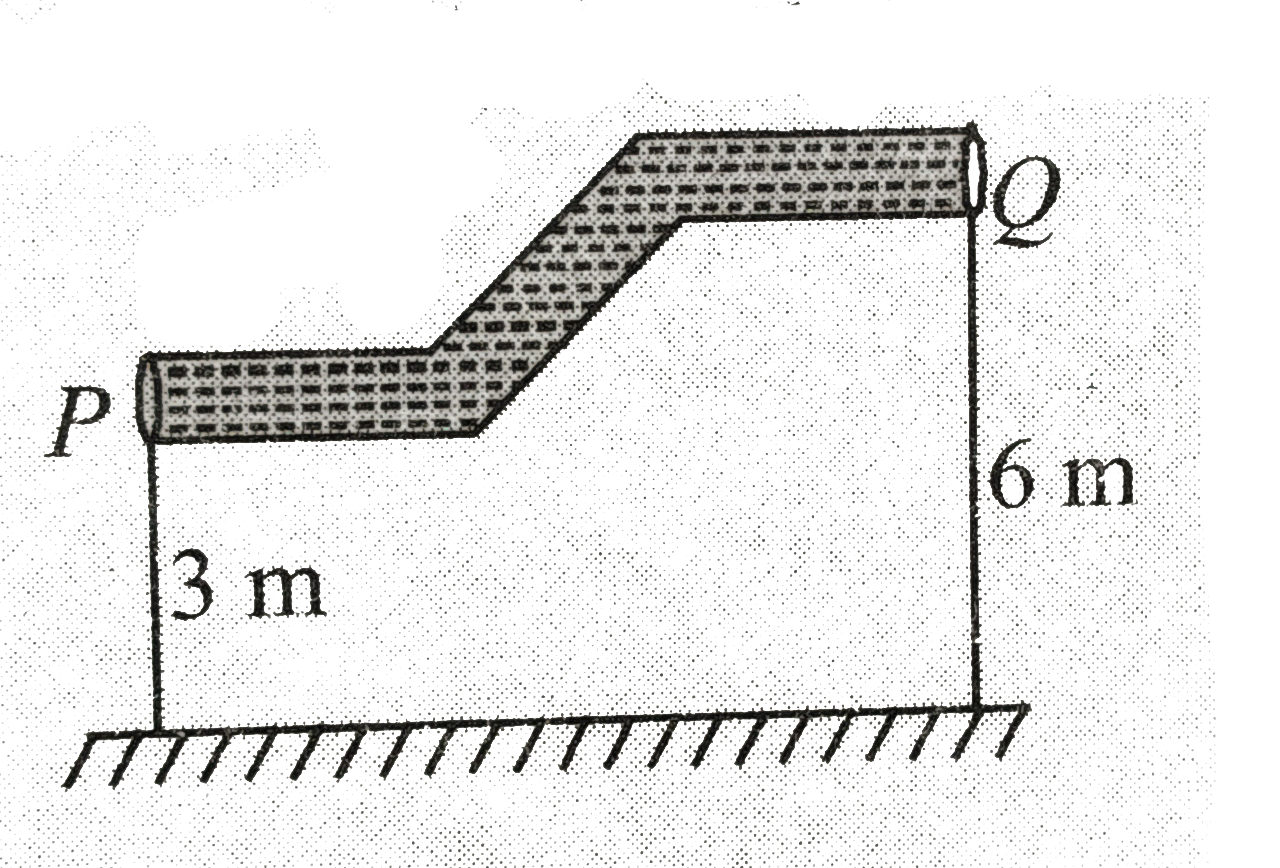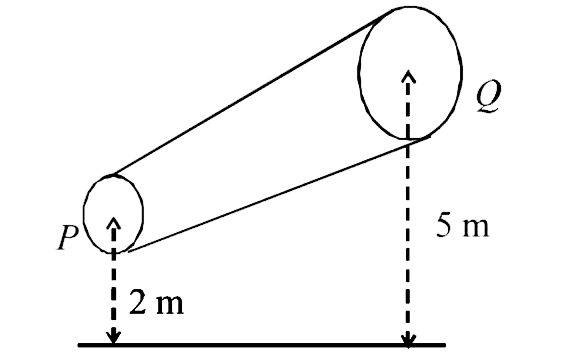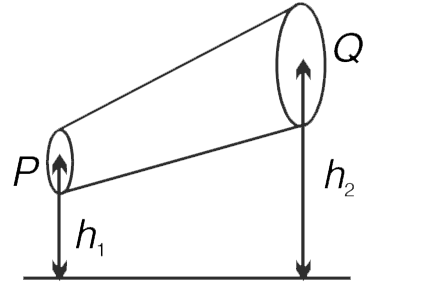A non-viscous liquid of constant density 500kg/m3 flows in a variable cross-sectional tube. The area of cross section of the tube at two points P and Q at heights of 3m and 6m are 2×10−3m3 and 4×10−3m3, respectively. Find the work done per unit volume by the forces of gravity as the fluid flows from point P to Q.

Work done by per unit volume by force of gravity
=− change in potential energy per unit volume
∴W=△U=−ρg(h2−h1)=−ρt(6−3)
=−3×500×10=−15×104J/m3
Topper's Solved these Questions
- FLUID MECHANICSBook:CENGAGE PHYSICSChapter:FLUID MECHANICSExercise:Subjective
Explore 25 Videos
- FLUID MECHANICSBook:CENGAGE PHYSICSChapter:FLUID MECHANICSExercise:Single Correct
Explore 95 Videos
- FLUID MECHANICSBook:CENGAGE PHYSICSChapter:FLUID MECHANICSExercise:Exercise 4.3
Explore 10 Videos
- DIMENSIONS & MEASUREMENTBook:CENGAGE PHYSICSChapter:DIMENSIONS & MEASUREMENTExercise:Integer
Explore 2 Videos
- GRAVITATIONBook:CENGAGE PHYSICSChapter:GRAVITATIONExercise:INTEGER_TYPE
Explore 1 Video
Similar Questions
A non-viscous liquid of constant density 1000kg/m3 flows in a streamline motion along a tube of variable cross section. The tube is kept inclined in the vertical plane as shown in Figure. The area of cross section of the tube two point P and Q at heights of 2 metres and 5 metres are respectively 4×10−3m2 and 8×10−3m2. The velocity of the liquid at point P is 1m/s. Find the work done per unit volume by the pressure and the gravity forces as the fluid flows from point P to Q.

View Solution(i) Air (density=ρ) flows through a horizontal venturi tube that discharges to the atmosphere. The area of cross section of the tube is A1 and at the constriction it is A2. The constriction is connected to a water (density=ρ0) tank through a vertical pipe of lenght H. Find the volume flow rate (Q) of the air through tube that is needed to just draw the water into the tube.

(ii) A non viscous liquid of constant density ρ flows in a stremline motion along a tube of variable cross section. The tube is kept inclined in the vertical plane as shown in the figure. The area of cross section of the tube at two points P and Q at heights of h1 and h2 are respectively A1 and A2. The velocity of the liquid at point P is v. Find the work done on a small volume ΔV of fluid by the neighbouring fluid as the small volume moves from P to Q.

View Solution
Knowledge Check
A non-viscous fluid of constant density of 1000kg/m3 flows in stream line motion along a tube of variable cross-section
 The area of cross-section at two P and Q at lengths 5m are 40cm2and20cm2 respectively. If velocity of fluid at P is 3m/s then find velocity of fluid at Q.A3m/sB4m/sC5m/sD6m/s
The area of cross-section at two P and Q at lengths 5m are 40cm2and20cm2 respectively. If velocity of fluid at P is 3m/s then find velocity of fluid at Q.A3m/sB4m/sC5m/sD6m/sA non viscous liquid of constant density 103kg/m3 flows in stream line motion along a vertical tube PQ of variable cross-section. Height of P and Q are 2m and 2.5m respectively. Area of tube at Q is equal to 3 times the area of tube at 'P'. Then work done per unit volume by pressure as liquid flows from P and Q. Speed of liquid at 'P' is 3m/s.
 A2000J/m3B1000J/m3C1500J/m3D9000J/m3
A2000J/m3B1000J/m3C1500J/m3D9000J/m3Speed of transverse wave in a string of density 100kg/m3 and area of cross-section 10mm2 under a tension of 1063 N is
A100m/sB1000m/sC200m/sD2000m/s
A liquid of density 800kg/m3 flowing steadily in a tube of varying cross-section. If area of cross-section at A is 4cm2 and at B is 2cm2. If speed of liquid at A is 10cm/s, calculate
(i) the rate of flow
(ii) the difference in pressures at A and B.
View SolutionIf 106 electrons/s are flowing through an area of cross section of 10−4m2 then the current will be:-
View SolutionA liquid of density 900 kg/m flows through a horizontal pipe that has a cross-sectional area of 1.90×10−2m2 in region A and a cross-sectional area of 9.50×10−2m2 in region B. The pressure difference between the two regions is 720×103 Pa. What are (a) the volume flow rate and (b) the mass flow rate?
View SolutionTwo metal spheres are falling through a liquid of density 2×103kg/m3 with the same uniform speed. The material density of sphere 1 and sphere 2 are 8×103kg/m3 and 11×103kg/m3 respectively. The ratio of their radii is :-
View SolutionAn ideal gas expands in volume from 1×103m3 at 300 K against a constant pressure of 1×105 N m−2.The work done is
View Solution

